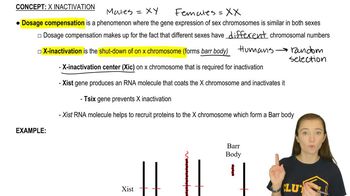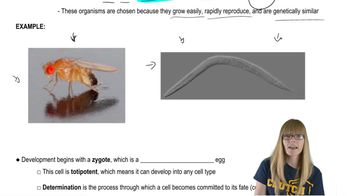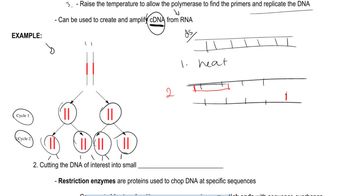Table of contents
- 1. Introduction to Genetics51m
- 2. Mendel's Laws of Inheritance3h 37m
- 3. Extensions to Mendelian Inheritance2h 41m
- 4. Genetic Mapping and Linkage2h 28m
- 5. Genetics of Bacteria and Viruses1h 21m
- 6. Chromosomal Variation1h 48m
- 7. DNA and Chromosome Structure56m
- 8. DNA Replication1h 10m
- 9. Mitosis and Meiosis1h 34m
- 10. Transcription1h 0m
- 11. Translation58m
- 12. Gene Regulation in Prokaryotes1h 19m
- 13. Gene Regulation in Eukaryotes44m
- 14. Genetic Control of Development44m
- 15. Genomes and Genomics1h 50m
- 16. Transposable Elements47m
- 17. Mutation, Repair, and Recombination1h 6m
- 18. Molecular Genetic Tools19m
- 19. Cancer Genetics29m
- 20. Quantitative Genetics1h 26m
- 21. Population Genetics50m
- 22. Evolutionary Genetics29m
18. Molecular Genetic Tools
Genetic Cloning
Problem 7c
Textbook Question
Using animal models of human diseases can lead to insights into the cellular and genetic bases of the diseases. Duchenne muscular dystrophy (DMD) is the consequence of an X-linked recessive allele. How would you make a mouse model of DMD?
 Verified step by step guidance
Verified step by step guidance1
Identify the gene responsible for Duchenne muscular dystrophy (DMD) in humans, which is the dystrophin gene located on the X chromosome.
Use genetic engineering techniques, such as CRISPR-Cas9, to introduce a mutation in the mouse dystrophin gene that mimics the human DMD mutation.
Ensure that the mutation is introduced in a way that it is X-linked and recessive, similar to the human condition, so that male mice (XY) will express the disease phenotype.
Breed the genetically modified mice to establish a stable line that consistently exhibits the DMD phenotype, allowing for further study and experimentation.
Validate the mouse model by comparing the symptoms and progression of the disease in the mice to those observed in human DMD patients, ensuring the model accurately reflects the human condition.
Recommended similar problem, with video answer:
 Verified Solution
Verified SolutionThis video solution was recommended by our tutors as helpful for the problem above
Video duration:
4mPlay a video:
Was this helpful?
Key Concepts
Here are the essential concepts you must grasp in order to answer the question correctly.
X-linked Recessive Inheritance
X-linked recessive inheritance refers to a pattern where a gene causing a trait or disorder is located on the X chromosome. Males, having one X and one Y chromosome, are more likely to express X-linked recessive traits because they have only one copy of the X chromosome. In contrast, females have two X chromosomes, so they can be carriers without showing symptoms if they have one normal allele.
Recommended video:
Guided course

X-Inactivation
Mouse Models in Genetics
Mouse models are genetically modified mice used to study human diseases. They allow researchers to investigate the genetic, cellular, and physiological aspects of diseases in a controlled environment. By creating specific mutations in mice that mimic human conditions, scientists can observe disease progression and test potential treatments, providing valuable insights into the underlying mechanisms.
Recommended video:
Guided course

Genetics of Development
Gene Editing Techniques
Gene editing techniques, such as CRISPR-Cas9, enable precise modifications of an organism's DNA. In the context of creating a mouse model for Duchenne muscular dystrophy, researchers can use these techniques to introduce mutations that replicate the disease-causing allele. This allows for the study of disease mechanisms and the evaluation of therapeutic strategies in a living organism.
Recommended video:
Guided course

Mapping Genes

 7:43m
7:43mWatch next
Master Genetic Cloning with a bite sized video explanation from Kylia Goodner
Start learningRelated Videos
Related Practice


